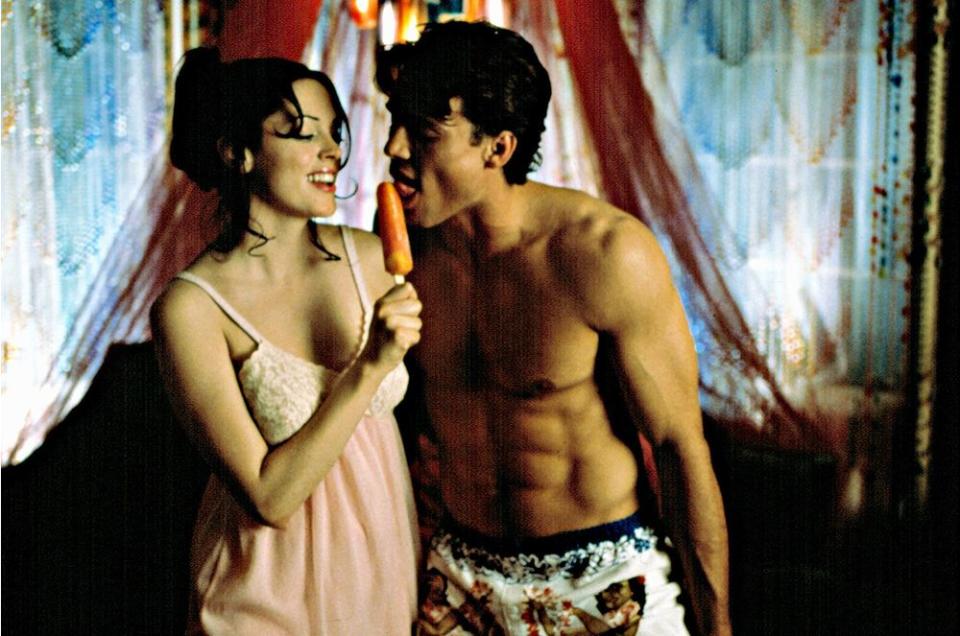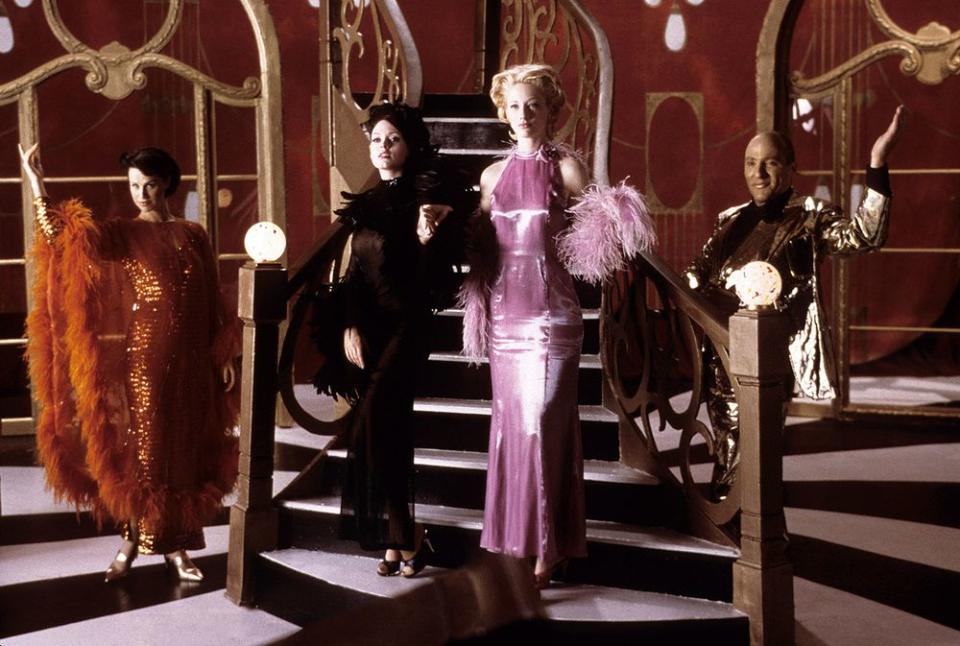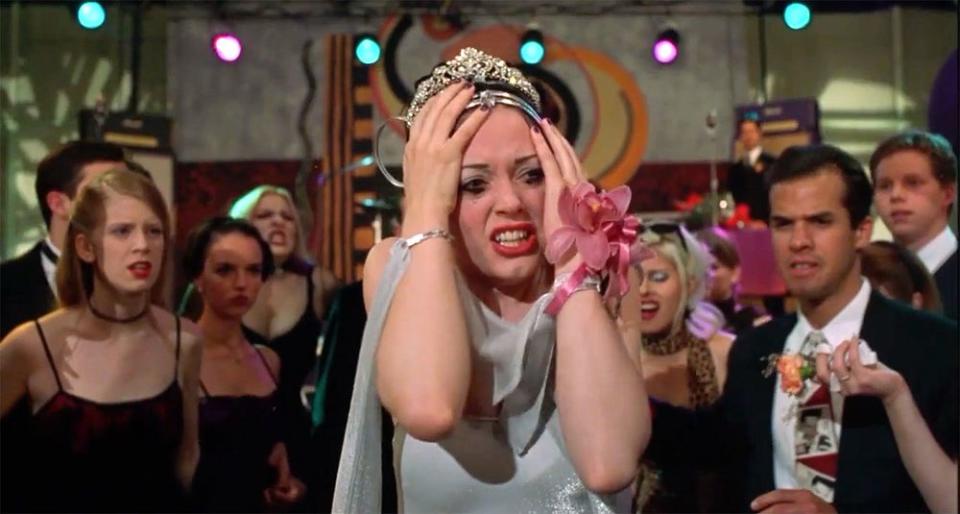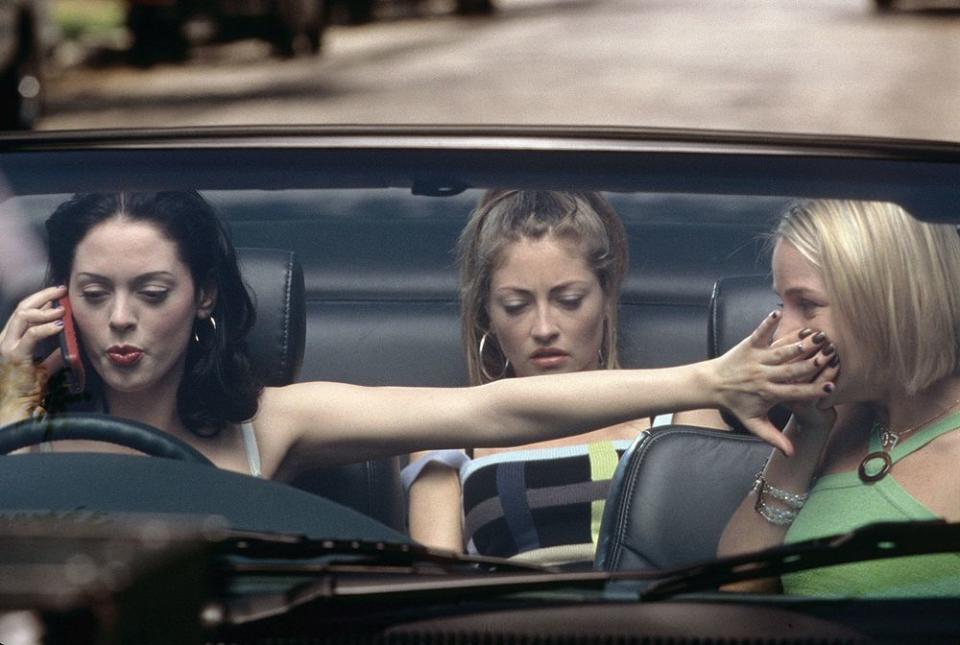An oral history of the pitch-black '90s comedy Jawbreaker
After debuting at the Sundance Film Festival, writer-director Darren Stein’s Jawbreaker hit theaters in February of 1999, a year that would later become known as a pinnacle for teen movies: American Pie, She’s All That, 10 Things I Hate About You, and Cruel Intentions are just a few others that arrived in that same 12-month span. A pitch-black comedy, Jawbreaker centers on a clique of popular girls (played by Rose McGowan, Rebecca Gayheart, and Julie Benz) who accidentally kill their friend Liz (Charlotte Ayanna) when she chokes on a jawbreaker during a prank; they then try to avoid the consequences until their secret is discovered by another classmate, Fern (Judy Greer).
Jawbreaker was unlike other teen movies that year (with their Shakespeare remixes, apple pie love scenes, and shady bets), which is perhaps why, despite negative reviews and a chilly box office reception, it went on to amass a cult following. It’s a film that parallels its namesake candy just a little too well: The shiny outer surface shocked viewers when it was released, but time has eroded its layers to reveal a film that was wildly ahead of its time in terms of aesthetics, fashion, music, and sexuality. Unlike other films of the era, it’s one that has aged well. As Stein told EW, “It’s meant to be mythic. Like the fashion, the dialogue is sort of out of time. The music is from all kinds of decades in the past. It’s not meant to be this very realistic film in the ’90s, it’s not that movie.”
In honor of Jawbreaker’s 20th anniversary and the recent release of a corresponding Blu-ray, EW got the tea behind the teen classic.
The Beginnings

Stein wrote the first draft of Jawbreaker in 1994, when he was 24. It took about four years to get made after that. Every studio Stein went to passed on it at the time, so it was a lot of hustle, which included him getting Parker Posey to read the script (she loved it, but said she had no high school left in her). He was simultaneously shopping the script for Sparkler, his first film, which ended up gaining more traction than Jawbreaker at the time; it was released in 1997. Finally, Jawbreaker got set up at Columbia TriStar in 1998.
DARREN STEIN (WRITER-DIRECTOR): I wanted to make a teen movie in the voice and the vision of a film that I would relate to and get excited about. Jawbreaker was the creation of the kind of high school I wanted to go to, but of course the more extreme version of that: dangerous and sexually provocative. It was something I hadn’t seen in other films. I’m very influenced by films like Faster, Pussycat! Kill! Kill!, Beyond the Valley of the Dolls, and even Rock ’n’ Roll High School. It does have influences of Heathers or other ’80s teen movies, but it reaches back into those heightened films.
ROSE MCGOWAN (COURTNEY SHAYNE): All I remember is getting the script and sitting on my back porch with my dogs and laughing the whole time, thinking, “I have to do this. This is Bette Davis, but in high school.” [I met with Darren], and he’s so great and has so much passion. There weren’t a lot of queer directors working at this point. I’d already worked with one, and I wanted to continue doing so because I wanted to further that in film.
JULIE BENZ (MARCIE “FOXY” FOX): It was one of my first movies where I actually had a starring role. I was thinking that I’ve got to get through this movie, do a good job, and work with these wonderful actresses. I was in awe of Rose because she was like this creature from outer space to me, just the most glamourous. And Rebecca I was a huge fan of for years. I thought she was one of the most beautiful women I had ever seen. So I was like, “How did I get here?”
REBECCA GAYHEART (JULIE FREEMAN): I remember meeting with Darren first, and then I went in and I read for two different roles. I think I read for Julie and Foxy and then they were like, “No, no, you were Julie.” I remember like everyone and their brother was reading for this movie because it was well-written and that it’s different, you know. Darren has a knack for teenagers, high school, and his vernacular. I just loved his point of view.
STEIN: I think it was great because we were all young and sort of fearless in the choices that we made. And because the film wasn’t made by a big studio, we were allowed to. That’s part of the magic of the movie, is that it was made by the home video division of Sony, which became Screen Gems later. It was $3 million and the other films that came out at the same time were $8 million-$15 million, like Cruel Intentions or Can’t Hardly Wait. We were so lucky to get the film made at all.
The Characters

Stein’s introduction to his mean-girl clique, slo-mo walking down a hallway while their peers looked on in awe and fear, became instantly documented in pop culture perpetuity. When Foxy, Julie, Courtney, and Liz are first introduced, they meld together as one super-clique, and after Liz’s death, their own personalities emerge. Liz, as the object of Fern Mayo’s affections, accidentally ends up being the catalyst for Fern’s transformation into Vylette.
STEIN: Frankenstein is a huge influence, as is Rocky Horror Picture Show. I always looked at Vylette as Courtney’s monster, Courtney’s creation. That juxtaposition was supposed to be like Liz getting prepared for death and Vylette getting prepared for popularity. I wanted to reference classical Hollywood movies, and that’s why it’s a mad-scientist kind of set at one point.
BENZ: I always viewed Foxy as the heavy. She was Courtney’s henchman. If Courtney was the mob boss, then Foxy was the one who went and did the killing and took care of it. She was a coward at heart.
GAYHEART: It was challenging because Julie is the straight person in the movie. I didn’t have outrageously fun scenes, so to speak. But what was great about her is that she was a very good representation of [how] kids are followers. And Julie made the choice to stop being a follower and stand up to the mean girls. I think Julie went through a really cool transformation. She started off as one of the mean girls, and she was sort of a loner because they kicked her out, and she had to do some soul searching and figure out who she was and what she stood for.
MCGOWAN: I was really inspired by this 1940s film, Leave Her to Heaven, with Gene Tierney. And I realized that to play a sociopath can be a really fun thing because they aren’t aware that they are evil. And that infused [playing Courtney] a lot. I wanted people to root for her, but not in a way that when a lot of actors play evil characters; they do it with a wink to the audience. I wanted her to really be that bad. Darren instinctively knew how to play it by just letting me be. I understood Courtney, and I’m glad I was the only one to play her.
JUDY GREER (FERN “VYLETTE” MAYO): I was, like, super-obsessed with some girls in a way where I would do anything to be friends with them. I felt exactly like Fern and Liz towards some women.
STEIN: I embrace Fern’s sexual ambiguity. People get obsessed and aren’t sure if they are gay or just obsessed. They want to be popular, and people will do a lot to be popular and be embraced. And the gray areas of those drives are interesting.
MCGOWAN: It was like, “Let’s all go for this big gay journey.” We wanted to corrupt the youth of America and beyond. I think that was our intent; that was certainly my intent. I thought [the popsicle scene] was so perverted and so great. And [Ethan Erickson, who portrayed Dane Sanders] was super down for it, and he played that dumb jock so perfectly. You couldn’t have asked for a better person to force to give head to a popsicle.
The Clothes

Even in 1999, the Teen Movie Year of Our Lord, Jawbreaker always remained a tad on the fringes. Among the very ’90s fashions of films like She’s All That and Drive Me Crazy, Jawbreaker’s bold colors, pearls, and vinyl channeled a much different fashion era than the one it existed in. And with dozens of articles praising the costuming a decade later, its fashion influence only became more relevant.
GAYHEART: Darren had a vision, and it was executed beautifully by Vikki [Barrett, the costume designer]. I think that it does have a timeless look because there’s a little bit of everything in it. It’s very detail-oriented. The stockings we wore with those leather skirts, Vikki sewed the seam down the back. It’s pretty fabulous. I do have a few items from my costumes that were given to me when we finished the movie. That purple latex skirt is not one of them — I never want to see that thing again.
MCGOWAN: I think one of the reasons that it looks so timeless is that we weren’t doing ’90s clothes. Every outfit had a really 1950s shape. Vikki, who did the costumes, was incredible, her detail work was incredible. I love the outfits, and I kept a lot of them.
BENZ: I love costume fittings in general, and that was one of my favorites because Vikki just had such a great eye. I just let her dress me, and everything was perfect. My prom dress was a Jessica McClintock, and she couldn’t get my size. It was a size too small and I tore it in the back, so we just kept putting the feather boa I had over it. I wanted to wear that dress so badly, and I was like, “I don’t care.” Everything was trashed by the end.
VIKKI BARRETT (COSTUME DESIGNER): Vylette’s dress, it was funny, I was just obsessed with that dress, but it was a size 20 or something. And everyone’s like, “There’s no way you can make this half the size,” and I was like, “I can make this half the size.” It fit her beautifully. Rebecca Gayheart’s was my favorite dress. I thought it was so pretty, and that fabric was so beautiful. I sprayed some little flowers blue, and we put those in her hair.
The Prom Scene

Jawbreaker might have one of the most legendary prom scenes in teen movie history: McGowan’s Courtney is crowned prom queen and revealed as a killer. The scene took three days to shoot at L.A.’s Dorsey High, where Buffy the Vampire Slayer also shot.
STEIN: It was it the most stylized sequence in the film. When Courtney was strapped to the dolly rig to make it appear like she was floating through the crowd and everyone was stoning her with corsages, I knew we had something special. There was a real venom coming from the crowd, and Rose was really in the zone playing up the operatics of it. I was actually concerned a needle would get left in a corsage and she’d get pricked.
MCGOWAN: I think it’s a really iconic moment because it’s pure comedy, but also in the most perverted way. It reminded me of the Greek tragedy and Greek chorus, very much in keeping with bad women throughout history.
BARRETT: For Rose, we wanted to do white, but then I thought it was too much. So the next step down would be silver, so it would still be gothic-y but she would still stand out in that crowd. I wanted there to be a big contrast with her, especially with things being thrown at her. I wanted her to pop out in the scene.
GAYHEART: I look at Rose’s silver dress with the silver things in her hair and when she’s pulling it out with the mascara running. It became a very vivid image of her in my head. And that’s what makes the movie memorable, you know?
MCGOWAN: The only prom I’ve ever been to was the prom in Jawbreaker, where I lose my mind and everyone is throwing corsages at me and screaming that I’m a murderer and a psycho. A peak Carrie moment.
STEIN: Alexander Wang used the prom scene as inspiration for a fashion film he wanted to do where a sample sale goes awry and shoppers literally tear each other apart — I ended up directing it. That was a pretty surreal, full-circle moment.
The Legacy

While Stein has directed films like G.B.F., he’s been working on a stage musical of Jawbreaker set for 2020, and is developing that into a half-hour series. And in the 20 years since its release, Jawbreaker has gained a whole new generation of fans, including Euphoria’s Barbie Ferreira, who recently told The Hollywood Reporter she’d love to star in a remake of the film. Clearly, the legacy of Jawbreaker is alive and well.
BENZ: I had an encounter where this very young girl, she must have been 20 years old, she came up to me and she’s like, “Oh my God, are you Julie Benz? You are in my favorite movie, Jawbreaker.” I was shocked because she was so young. And she was like, “You are like a legend. You’re epic. Are you still working?” And I was like, “Yeah I am.” I still think I’m too young to be a legend. I’m not there yet.
GAYHEART: I have a lot of young babysitters who help me with my girls, and all of the babysitters are like, “Oh my God, I watched Jawbreaker when I was 7,” and I’m like, “Wait a minute.” But they all like Jawbreaker, and it’s a part of their childhood memories.
GREER: A really cute boy who worked in Sephora slipped me a note and just squeezed my hand. And I was like, “Oh thanks!.” I read it later and it was like, “You’re a gay icon. Thank you so much for what you did in Jawbreaker.”
MCGOWAN: I was walking down the street with a friend in Berlin, and he was telling me about how he recently watched it again after seeing it in high school and he was like, “That’s what made me realize I was gay.” Its legacy is one of acceptance and love, even though it’s not a movie about love per se. It was a benchmark in teen movies.
GREER: I remember Darren saying on set that he wanted to make a cult classic.
STEIN: Wow, that’s presumptuous of me.
GREER: I love that about you. I remember thinking, “How do you know something is going to catch on like that?” And you were totally right. Maybe it was because it was one of the first jobs I had, but it has stood the test of time and new audiences are finding it, and that’s really impressive.
STEIN: Modern me would look back to 27-year-old me and be like, “You can’t announce that you are going to make a cult classic. It needs to become one. It’s not something a filmmaker can conjure up.”
BENZ: But you did!
Related content:
